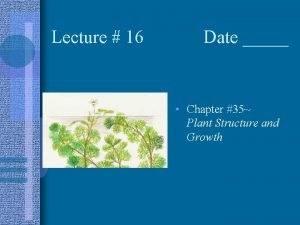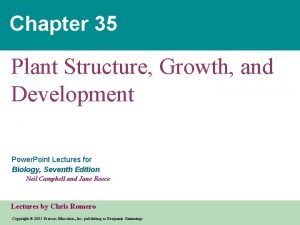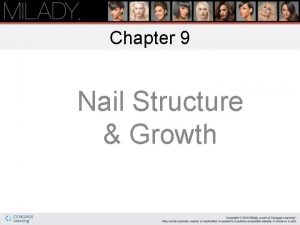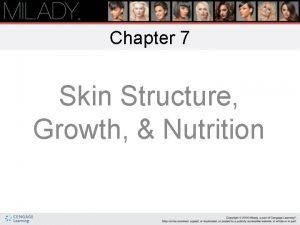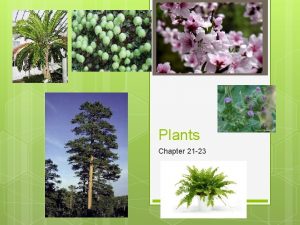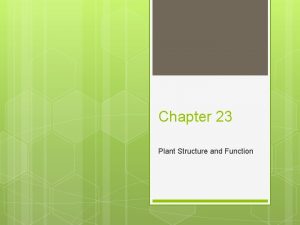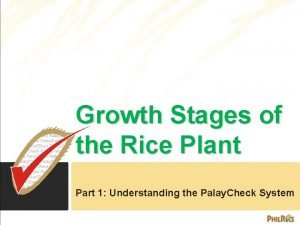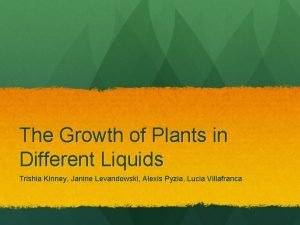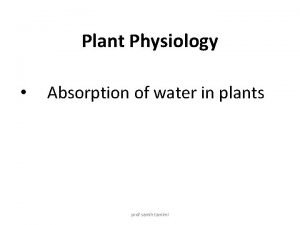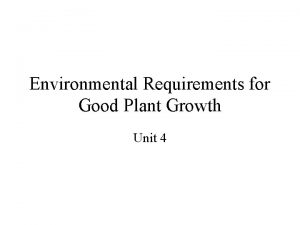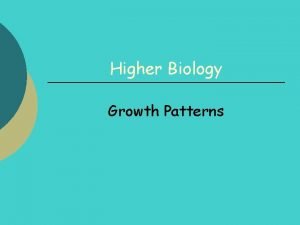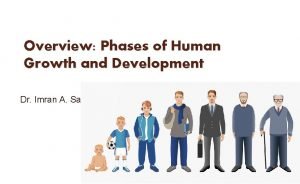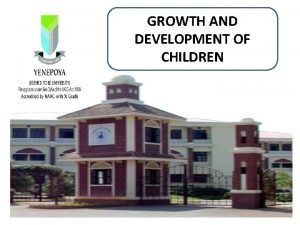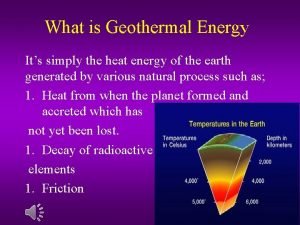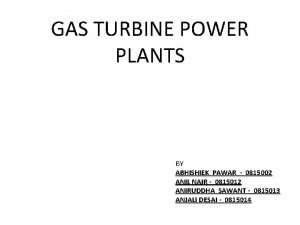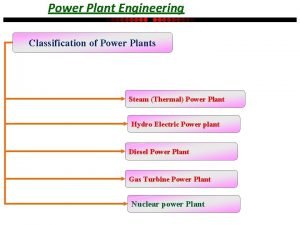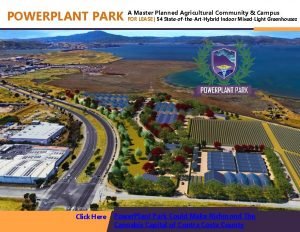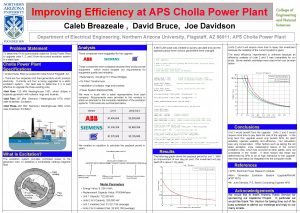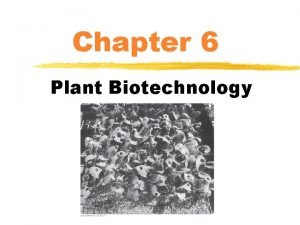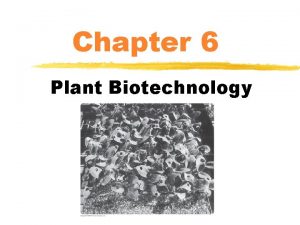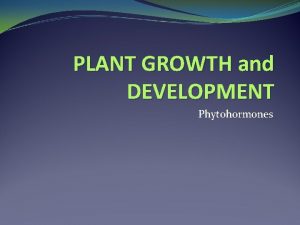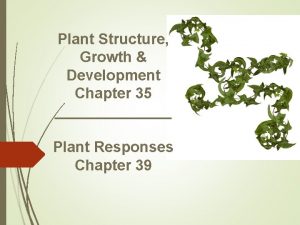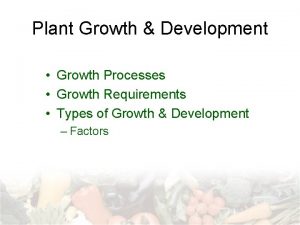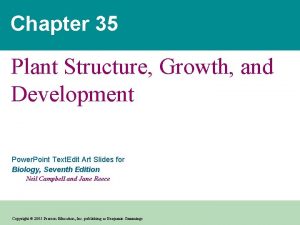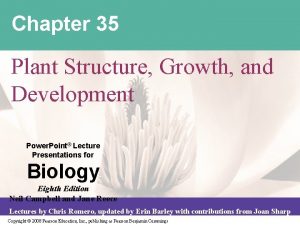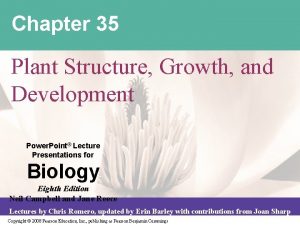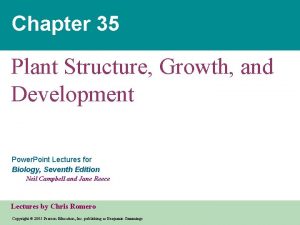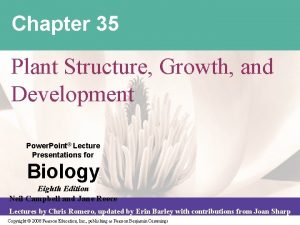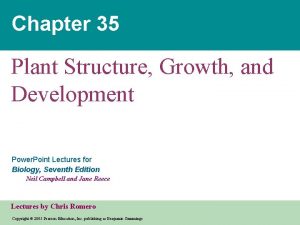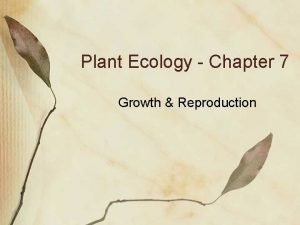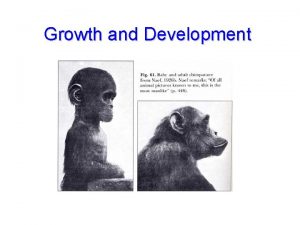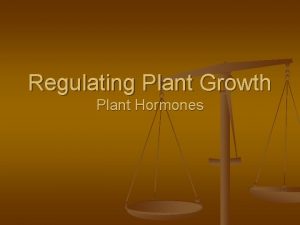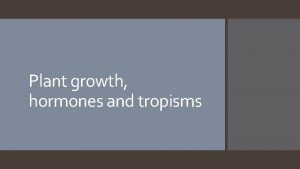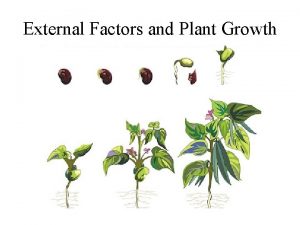Chapter 35 Plant Structure Growth and Development Power





























































































- Slides: 93

Chapter 35 Plant Structure, Growth, and Development Power. Point® Lecture Presentations for Biology Eighth Edition Neil Campbell and Jane Reece Lectures by Chris Romero, updated by Erin Barley with contributions from Joan Sharp Copyright © 2008 Pearson Education, Inc. , publishing as Pearson Benjamin Cummings

Overview: Plastic Plants? • To some people, the fanwort is an intrusive weed, but to others it is an attractive aquarium plant • This plant exhibits developmental plasticity, the ability to alter itself in response to its environment • In addition to plasticity, plant species have by natural selection accumulated characteristics of morphology that vary little within the species Copyright © 2008 Pearson Education, Inc. , publishing as Pearson Benjamin Cummings


Concept 35. 1: The plant body has a hierarchy of organs, tissues, and cells • Plants, like multicellular animals, have organs composed of different tissues, which in turn are composed of cells • Basic morphology of vascular plants reflects their evolution as organisms that draw nutrients from below ground above ground Copyright © 2008 Pearson Education, Inc. , publishing as Pearson Benjamin Cummings

• Three basic organs evolved: roots, stems, and leaves • They are organized into a root system and a shoot system • Roots rely on sugar produced by photosynthesis in the shoot system, and shoots rely on water and minerals absorbed by the root system Copyright © 2008 Pearson Education, Inc. , publishing as Pearson Benjamin Cummings

Reproductive shoot (flower) Apical bud Node Internode Apical bud Vegetative shoot Leaf Shoot system Blade Petiole Axillary bud Stem Taproot Lateral branch roots Root system

Roots • Roots are multicellular organs with important functions: – Anchoring the plant – Absorbing minerals and water – Storing organic nutrients Copyright © 2008 Pearson Education, Inc. , publishing as Pearson Benjamin Cummings

• A taproot system consists of one main vertical root that gives rise to lateral roots, or branch roots • Adventitious roots arise from stems or leaves • Seedless vascular plants and monocots have a fibrous root system characterized by thin lateral roots with no main root Copyright © 2008 Pearson Education, Inc. , publishing as Pearson Benjamin Cummings

• In most plants, absorption of water and minerals occurs near the root hairs, where vast numbers of tiny root hairs increase the surface area Copyright © 2008 Pearson Education, Inc. , publishing as Pearson Benjamin Cummings

Prop roots “Strangling” aerial roots Storage roots Buttress roots Pneumatophores

Stems • A stem is an organ consisting of – An alternating system of nodes, the points at which leaves are attached – Internodes, the stem segments between nodes Copyright © 2008 Pearson Education, Inc. , publishing as Pearson Benjamin Cummings

• An axillary bud is a structure that has the potential to form a lateral shoot, or branch • An apical bud, or terminal bud, is located near the shoot tip and causes elongation of a young shoot • Apical dominance helps to maintain dormancy in most nonapical buds Copyright © 2008 Pearson Education, Inc. , publishing as Pearson Benjamin Cummings

Rhizomes Bulbs Storage leaves Stem Stolons Stolon Tubers

Leaves • The leaf is the main photosynthetic organ of most vascular plants • Leaves generally consist of a flattened blade and a stalk called the petiole, which joins the leaf to a node of the stem Copyright © 2008 Pearson Education, Inc. , publishing as Pearson Benjamin Cummings

• Monocots and eudicots differ in the arrangement of veins, the vascular tissue of leaves – Most monocots have parallel veins – Most eudicots have branching veins • In classifying angiosperms, taxonomists may use leaf morphology as a criterion Copyright © 2008 Pearson Education, Inc. , publishing as Pearson Benjamin Cummings

(a) Simple leaf Petiole Axillary bud Leaflet (b) Compound leaf Petiole Axillary bud (c) Doubly compound leaf Leaflet Petiole Axillary bud

Tendrils Some plant species have evolved modified leaves that serve various functions Spines Storage leaves Reproductive leaves Bracts

Dermal, Vascular, and Ground Tissues • Each plant organ has dermal, vascular, and ground tissues • Each of these three categories forms a tissue system Copyright © 2008 Pearson Education, Inc. , publishing as Pearson Benjamin Cummings

Dermal tissue Ground tissue Vascular tissue

• In nonwoody plants, the dermal tissue system consists of the epidermis • A waxy coating called the cuticle helps prevent water loss from the epidermis • In woody plants, protective tissues called periderm replace the epidermis in older regions of stems and roots • Trichomes are outgrowths of the shoot epidermis and can help with insect defense Copyright © 2008 Pearson Education, Inc. , publishing as Pearson Benjamin Cummings

EXPERIMENT Very hairy pod (10 trichomes/ mm 2) Slightly hairy pod (2 trichomes/ mm 2) Bald pod (no trichomes) RESULTS Very hairy pod: 10% damage Slightly hairy pod: 25% damage Bald pod: 40% damage

• The vascular tissue system carries out longdistance transport of materials between roots and shoots • The two vascular tissues are xylem and phloem • Xylem conveys water and dissolved minerals upward from roots into the shoots • Phloem transports organic nutrients from where they are made to where they are needed Copyright © 2008 Pearson Education, Inc. , publishing as Pearson Benjamin Cummings

• The vascular tissue of a stem or root is collectively called the stele • In angiosperms the stele of the root is a solid central vascular cylinder • The stele of stems and leaves is divided into vascular bundles, strands of xylem and phloem Copyright © 2008 Pearson Education, Inc. , publishing as Pearson Benjamin Cummings

• Tissues that are neither dermal nor vascular are the ground tissue system • Ground tissue internal to the vascular tissue is pith; ground tissue external to the vascular tissue is cortex • Ground tissue includes cells specialized for storage, photosynthesis, and support Copyright © 2008 Pearson Education, Inc. , publishing as Pearson Benjamin Cummings

• Some major types of plant cells: – Parenchyma – Collenchyma – Sclerenchyma – Water-conducting cells of the xylem – Sugar-conducting cells of the phloem Copyright © 2008 Pearson Education, Inc. , publishing as Pearson Benjamin Cummings

Parenchyma Cells • Mature parenchyma cells – Have thin and flexible primary walls – Lack secondary walls – Are the least specialized – Perform the most metabolic functions – Retain the ability to divide and differentiate Copyright © 2008 Pearson Education, Inc. , publishing as Pearson Benjamin Cummings

Parenchyma cells in Elodea leaf, with chloroplasts (LM) 60 µm

Collenchyma Cells • Collenchyma cells are grouped in strands and help support young parts of the plant shoot • They have thicker and uneven cell walls • They lack secondary walls • These cells provide flexible support without restraining growth Copyright © 2008 Pearson Education, Inc. , publishing as Pearson Benjamin Cummings

5 µm Collenchyma cells (in Helianthus stem) (LM)

Sclerenchyma Cells • Sclerenchyma cells are rigid because of thick secondary walls strengthened with lignin • They are dead at functional maturity • There are two types: – Sclereids are short and irregular in shape and have thick lignified secondary walls – Fibers are long and slender and arranged in threads Copyright © 2008 Pearson Education, Inc. , publishing as Pearson Benjamin Cummings

5 µm Sclereid cells in pear (LM) 25 µm Cell wall Fiber cells (cross section from ash tree) (LM)

Vessel Tracheids 100 µm Pits Tracheids and vessels (colorized SEM) Perforation plate Vessel elements, with perforated end walls Tracheids

Water-Conducting Cells of the Xylem • The two types of water-conducting cells, tracheids and vessel elements, are dead at maturity • Tracheids are found in the xylem of all vascular plants • Vessel elements are common to most angiosperms and a few gymnosperms • Vessel elements align end to form long micropipes called vessels Copyright © 2008 Pearson Education, Inc. , publishing as Pearson Benjamin Cummings

Sieve-tube elements: longitudinal view (LM) 3 µm Sieve plate Sieve-tube element (left) and companion cell: cross section (TEM) Companion cells Sieve-tube elements Plasmodesma Sieve plate Nucleus of companion cells Sieve-tube elements: longitudinal view 30 µm 10 µm Sieve plate with pores (SEM)

Sugar-Conducting Cells of the Phloem • Sieve-tube elements are alive at functional maturity, though they lack organelles • Sieve plates are the porous end walls that allow fluid to flow between cells along the sieve tube • Each sieve-tube element has a companion cell whose nucleus and ribosomes serve both cells Copyright © 2008 Pearson Education, Inc. , publishing as Pearson Benjamin Cummings

Sieve-tube elements: longitudinal view (LM) Sieve plate Companion cells Sieve-tube elements 30 µm

Sieve-tube element Plasmodesma Sieve plate 10 µm Nucleus of companion cells Sieve-tube elements: longitudinal view Sieve plate with pores (SEM)

Concept 35. 2: Meristems generate cells for new organs • A plant can grow throughout its life; this is called indeterminate growth • Some plant organs cease to grow at a certain size; this is called determinate growth • Annuals complete their life cycle in a year or less • Biennials require two growing seasons • Perennials live for many years Copyright © 2008 Pearson Education, Inc. , publishing as Pearson Benjamin Cummings

• Meristems are perpetually embryonic tissue and allow for indeterminate growth • Apical meristems are located at the tips of roots and shoots and at the axillary buds of shoots • Apical meristems elongate shoots and roots, a process called primary growth Copyright © 2008 Pearson Education, Inc. , publishing as Pearson Benjamin Cummings

• Lateral meristems add thickness to woody plants, a process called secondary growth • There are two lateral meristems: the vascular cambium and the cork cambium • The vascular cambium adds layers of vascular tissue called secondary xylem (wood) and secondary phloem • The cork cambium replaces the epidermis with periderm, which is thicker and tougher Copyright © 2008 Pearson Education, Inc. , publishing as Pearson Benjamin Cummings

Primary growth in stems Epidermis Cortex Shoot tip (shoot apical meristem and young leaves) Primary phloem Primary xylem Pith Lateral meristems: Axillary bud meristem Vascular cambium Cork cambium Secondary growth in stems Periderm Cork cambium Cortex Root apical meristems Pith Primary xylem Secondary xylem Vascular cambium Primary phloem Secondary phloem

• Meristems give rise to initials, which remain in the meristem, and derivatives, which become specialized in developing tissues • In woody plants, primary and secondary growth occur simultaneously but in different locations Copyright © 2008 Pearson Education, Inc. , publishing as Pearson Benjamin Cummings

Apical bud Bud scale Axillary buds This year’s growth (one year old) Leaf scar Bud scar Node Internode Last year’s growth (two years old) One-year-old side branch formed from axillary bud near shoot tip Leaf scar Stem Bud scar left by apical bud scales of previous winters Growth of two years ago (three years old) Leaf scar

Concept 35. 3: Primary growth lengthens roots and shoots • Primary growth produces the primary plant body, the parts of the root and shoot systems produced by apical meristems Copyright © 2008 Pearson Education, Inc. , publishing as Pearson Benjamin Cummings

Primary Growth of Roots • The root tip is covered by a root cap, which protects the apical meristem as the root pushes through soil • Growth occurs just behind the root tip, in three zones of cells: – Zone of cell division – Zone of elongation – Zone of maturation Copyright © 2008 Pearson Education, Inc. , publishing as Pearson Benjamin Cummings

Cortex Vascular cylinder Epidermis Key to labels Dermal Root hair Zone of differentiation Ground Vascular Zone of elongation Apical meristem Root cap 100 µm Zone of cell division

• The primary growth of roots produces the epidermis, ground tissue, and vascular tissue • In most roots, the stele is a vascular cylinder • The ground tissue fills the cortex, the region between the vascular cylinder and epidermis • The innermost layer of the cortex is called the endodermis Copyright © 2008 Pearson Education, Inc. , publishing as Pearson Benjamin Cummings

Epidermis Cortex Endodermis Vascular cylinder Pericycle Core of parenchyma cells Xylem 100 µm Phloem 100 µm (a) Root with xylem and phloem in the center (typical of eudicots) (b) Root with parenchyma in the center (typical of monocots) Endodermis Pericycle Key to labels Dermal Ground Vascular Xylem Phloem 50 µm

Primary Growth of Shoots • A shoot apical meristem is a dome-shaped mass of dividing cells at the shoot tip • Leaves develop from leaf primordia along the sides of the apical meristem • Axillary buds develop from meristematic cells left at the bases of leaf primordia Copyright © 2008 Pearson Education, Inc. , publishing as Pearson Benjamin Cummings

Shoot apical meristem Leaf primordia Young leaf Developing vascular strand Axillary bud meristems 0. 25 mm

Tissue Organization of Stems • Lateral shoots develop from axillary buds on the stem’s surface • In most eudicots, the vascular tissue consists of vascular bundles that are arranged in a ring • In most monocot stems, the vascular bundles are scattered throughout the ground tissue, rather than forming a ring Copyright © 2008 Pearson Education, Inc. , publishing as Pearson Benjamin Cummings

Phloem Xylem Sclerenchyma (fiber cells) Ground tissue connecting pith to cortex Pith Epidermis Key to labels Cortex Epidermis Vascular bundle Dermal Vascular bundles Ground 1 mm (a) Cross section of stem with vascular bundles forming a ring (typical of eudicots) Vascular 1 mm (b) Cross section of stem with scattered vascular bundles (typical of monocots)

Tissue Organization of Leaves • The epidermis in leaves is interrupted by stomata, which allow CO 2 exchange between the air and the photosynthetic cells in a leaf • Each stomatal pore is flanked by two guard cells, which regulate its opening and closing • The ground tissue in a leaf, called mesophyll, is sandwiched between the upper and lower epidermis Copyright © 2008 Pearson Education, Inc. , publishing as Pearson Benjamin Cummings

• Below the palisade mesophyll in the upper part of the leaf is loosely arranged spongy mesophyll, where gas exchange occurs • The vascular tissue of each leaf is continuous with the vascular tissue of the stem • Veins are the leaf’s vascular bundles and function as the leaf’s skeleton • Each vein in a leaf is enclosed by a protective bundle sheath Copyright © 2008 Pearson Education, Inc. , publishing as Pearson Benjamin Cummings

Guard cells Key to labels Dermal Ground Vascular Cuticle 50 µm Stomatal pore Epidermal cell Sclerenchyma fibers Stoma (b) Surface view of a spiderwort (Tradescantia) leaf (LM) Upper epidermis Palisade mesophyll 100 µm Spongy mesophyll Bundlesheath cell Lower epidermis Cuticle Xylem Vein Phloem (a) Cutaway drawing of leaf tissues Guard cells Vein Air spaces Guard cells (c) Cross section of a lilac (Syringa)) leaf (LM)

Concept 35. 4: Secondary growth adds girth to stems and roots in woody plants • Secondary growth occurs in stems and roots of woody plants but rarely in leaves • The secondary plant body consists of the tissues produced by the vascular cambium and cork cambium • Secondary growth is characteristic of gymnosperms and many eudicots, but not monocots Copyright © 2008 Pearson Education, Inc. , publishing as Pearson Benjamin Cummings

Pith Primary xylem Vascular cambium Primary phloem (a) Primary and secondary growth in a two-year-old stem Epidermis Cortex Epidermis Primary phloem Vascular cambium Primary xylem Pith wth Gro Vascular ray Secondary xylem Secondary phloem First cork cambium Cork Periderm (mainly cork cambia and cork) Most recent cork cambium Secondary phloem Bark Secondary xylem Cork Layers of periderm

Secondary xylem Secondary phloem Vascular cambium Late wood Early wood Bark Cork cambium Periderm 0. 5 mm Cork Vascular ray 0. 5 mm Growth ring (b) Cross section of a three-yearold Tilia (linden) stem (LM)

The Vascular Cambium and Secondary Vascular Tissue • The vascular cambium is a cylinder of meristematic cells one cell layer thick • It develops from undifferentiated parenchyma cells • In cross section, the vascular cambium appears as a ring of initials • The initials increase the vascular cambium’s circumference and add secondary xylem to the inside and secondary phloem to the outside Copyright © 2008 Pearson Education, Inc. , publishing as Pearson Benjamin Cummings

Vascular cambium Growth X X C P P Secondary xylem Secondary phloem X C P C C X X C P Vascular cambium C C C X C C C After one year of growth After two years of growth

• Secondary xylem accumulates as wood, and consists of tracheids, vessel elements (only in angiosperms), and fibers • Early wood, formed in the spring, has thin cell walls to maximize water delivery • Late wood, formed in late summer, has thickwalled cells and contributes more to stem support • In temperate regions, the vascular cambium of perennials is dormant through the winter Copyright © 2008 Pearson Education, Inc. , publishing as Pearson Benjamin Cummings

• Tree rings are visible where late and early wood meet, and can be used to estimate a tree’s age • Dendrochronology is the analysis of tree ring growth patterns, and can be used to study past climate change Copyright © 2008 Pearson Education, Inc. , publishing as Pearson Benjamin Cummings

RESULTS Ring-width indexes 2 1. 5 1 0. 5 0 1600 1700 1800 Year 1900 2000

• As a tree or woody shrub ages, the older layers of secondary xylem, the heartwood, no longer transport water and minerals • The outer layers, known as sapwood, still transport materials through the xylem • Older secondary phloem sloughs off and does not accumulate Copyright © 2008 Pearson Education, Inc. , publishing as Pearson Benjamin Cummings

Growth ring Vascular ray Heartwood Secondary xylem Sapwood Vascular cambium Secondary phloem Bark Layers of periderm


The Cork Cambium and the Production of Periderm • The cork cambium gives rise to the secondary plant body’s protective covering, or periderm • Periderm consists of the cork cambium plus the layers of cork cells it produces • Bark consists of all the tissues external to the vascular cambium, including secondary phloem and periderm • Lenticels in the periderm allow for gas exchange between living stem or root cells and the outside air Copyright © 2008 Pearson Education, Inc. , publishing as Pearson Benjamin Cummings

Concept 35. 5: Growth, morphogenesis, and differentiation produce the plant body • Morphogenesis is the development of body form and organization • The three developmental processes of growth, morphogenesis, and cellular differentiation act in concert to transform the fertilized egg into a plant Copyright © 2008 Pearson Education, Inc. , publishing as Pearson Benjamin Cummings

Molecular Biology: Revolutionizing the Study of Plants • New techniques and model systems are catalyzing explosive progress in our understanding of plants • Arabidopsis is a model organism, and the first plant to have its entire genome sequenced • Studying the genes and biochemical pathways of Arabidopsis will provide insights into plant development, a major goal of systems biology Copyright © 2008 Pearson Education, Inc. , publishing as Pearson Benjamin Cummings

Other metabolism (18%) DNA or RNA metabolism (1%) Signal transduction (2%) Development (2%) Energy pathways (3%) Unknown Cell division and (24%) organization (3%) Transport (4%) Transcription (4%) Response to environment (4%) Protein metabolism (7%) Other cellular processes (17%) Other biological processes (11%)

The Plane and Symmetry of Cell Division • The plane (direction) and symmetry of cell division are immensely important in determining plant form • If the planes of division are parallel to the plane of the first division, a single file of cells is produced • If the planes of division vary randomly, asymmetrical cell division occurs Copyright © 2008 Pearson Education, Inc. , publishing as Pearson Benjamin Cummings

Plane of cell division (a) Planes of cell division Developing guard cells Unspecialized epidermal cell (b) Asymmetrical cell division Guard cell “mother cell”

• The plane in which a cell divides is determined during late interphase • Microtubules become concentrated into a ring called the preprophase band that predicts the future plane of cell division Copyright © 2008 Pearson Education, Inc. , publishing as Pearson Benjamin Cummings

Preprophase bands of microtubules Nuclei Cell plates 10 µm

Orientation of Cell Expansion • Plant cells grow rapidly and “cheaply” by intake and storage of water in vacuoles • Plant cells expand primarily along the plant’s main axis • Cellulose microfibrils in the cell wall restrict the direction of cell elongation Copyright © 2008 Pearson Education, Inc. , publishing as Pearson Benjamin Cummings

Cellulose microfibrils Nucleus Vacuoles 5 µm

0. 3 mm (a) Wild-type seedling 2 mm (b) fass seedling (c) Mature fass mutant

Morphogenesis and Pattern Formation • Pattern formation is the development of specific structures in specific locations • It is determined by positional information in the form of signals indicating to each cell its location • Positional information may be provided by gradients of molecules • Polarity, having structural or chemical differences at opposite ends of an organism, provides one type of positional information Copyright © 2008 Pearson Education, Inc. , publishing as Pearson Benjamin Cummings

• Morphogenesis in plants, as in other multicellular organisms, is often controlled by homeotic genes Copyright © 2008 Pearson Education, Inc. , publishing as Pearson Benjamin Cummings

Overexpression of a homeotic gene in leaf formation

Gene Expression and Control of Cellular Differentiation • In cellular differentiation, cells of a developing organism synthesize different proteins and diverge in structure and function even though they have a common genome • Cellular differentiation to a large extent depends on positional information and is affected by homeotic genes Copyright © 2008 Pearson Education, Inc. , publishing as Pearson Benjamin Cummings

20 µm Cortical cells

Location and a Cell’s Developmental Fate • Positional information underlies all the processes of development: growth, morphogenesis, and differentiation • Cells are not dedicated early to forming specific tissues and organs • The cell’s final position determines what kind of cell it will become Copyright © 2008 Pearson Education, Inc. , publishing as Pearson Benjamin Cummings

Shifts in Development: Phase Changes • Plants pass through developmental phases, called phase changes, developing from a juvenile phase to an adult phase • Phase changes occur within the shoot apical meristem • The most obvious morphological changes typically occur in leaf size and shape Copyright © 2008 Pearson Education, Inc. , publishing as Pearson Benjamin Cummings

Leaves produced by adult phase of apical meristem Leaves produced by juvenile phase of apical meristem

Genetic Control of Flowering • Flower formation involves a phase change from vegetative growth to reproductive growth • It is triggered by a combination of environmental cues and internal signals • Transition from vegetative growth to flowering is associated with the switching on of floral meristem identity genes Copyright © 2008 Pearson Education, Inc. , publishing as Pearson Benjamin Cummings

• Plant biologists have identified several organ identity genes (plant homeotic genes) that regulate the development of floral pattern • A mutation in a plant organ identity gene can cause abnormal floral development Copyright © 2008 Pearson Education, Inc. , publishing as Pearson Benjamin Cummings

Pe Ca St Se Pe Se (a) Normal Arabidopsis flower Pe Pe Se (b) Abnormal Arabidopsis flower

• Researchers have identified three classes of floral organ identity genes • The ABC model of flower formation identifies how floral organ identity genes direct the formation of the four types of floral organs • An understanding of mutants of the organ identity genes depicts how this model accounts for floral phenotypes Copyright © 2008 Pearson Education, Inc. , publishing as Pearson Benjamin Cummings

Fig. 35 -34 a Sepals Petals Stamens A B (a) A schematic diagram of the ABC hypothesis Carpels C A+B gene activity B+C gene activity Carpel Petal A gene activity Stamen Sepal

You should now be able to: 1. Compare the following structures or cells: – Fibrous roots, taproots, root hairs, adventitious roots – Dermal, vascular, and ground tissues – Monocot leaves and eudicot leaves – Parenchyma, collenchyma, sclerenchyma, water-conducting cells of the xylem, and sugar-conducting cells of the phloem – Sieve-tube element and companion cell Copyright © 2008 Pearson Education, Inc. , publishing as Pearson Benjamin Cummings

2. Explain the phenomenon of apical dominance 3. Distinguish between determinate and indeterminate growth 4. Describe in detail the primary and secondary growth of the tissues of roots and shoots 5. Describe the composition of wood and bark Copyright © 2008 Pearson Education, Inc. , publishing as Pearson Benjamin Cummings

6. Distinguish between morphogenesis, differentiation, and growth 7. Explain how a vegetative shoot tip changes into a floral meristem Copyright © 2008 Pearson Education, Inc. , publishing as Pearson Benjamin Cummings
 Chapter 35 plant structure growth and development
Chapter 35 plant structure growth and development Vascular ray
Vascular ray Xylem und phloem
Xylem und phloem Rice plant stages
Rice plant stages Plant biology ppt
Plant biology ppt Chapter 7 human growth and development
Chapter 7 human growth and development Power triangle diagram
Power triangle diagram Plant growth definition
Plant growth definition Monocots vs eudicots
Monocots vs eudicots Primary growth and secondary growth in plants
Primary growth and secondary growth in plants Milady nail structure and growth
Milady nail structure and growth As a person ages parts of the nail matrix
As a person ages parts of the nail matrix Skin structure growth and nutrition
Skin structure growth and nutrition Chapter 14 section 1 the growth of presidential power
Chapter 14 section 1 the growth of presidential power Chapter 14 section 1 the growth of presidential power
Chapter 14 section 1 the growth of presidential power Chapter 22 plant structure and function answer key
Chapter 22 plant structure and function answer key Chapter 21 plant structure and function
Chapter 21 plant structure and function Chapter 23 plant structure and function
Chapter 23 plant structure and function Carothers equation
Carothers equation Geometric growth population
Geometric growth population Neoclassical growth theory vs. endogenous growth theory
Neoclassical growth theory vs. endogenous growth theory Organic vs inorganic growth
Organic vs inorganic growth Tronsmo plant pathology and plant diseases download
Tronsmo plant pathology and plant diseases download Tronsmo plant pathology and plant diseases download
Tronsmo plant pathology and plant diseases download Tronsmo plant pathology and plant diseases download
Tronsmo plant pathology and plant diseases download Stages of rice plant
Stages of rice plant Plant growth with different liquids
Plant growth with different liquids Significance of transpiration
Significance of transpiration Role of transpiration
Role of transpiration Environmental requirements for good plant growth
Environmental requirements for good plant growth Plant growth patterns
Plant growth patterns Social changes in adulthood
Social changes in adulthood Theories about
Theories about Stages of human growth and development pictures
Stages of human growth and development pictures Late childhood
Late childhood Pretest: growth, development, and sexuality
Pretest: growth, development, and sexuality Maturation growth and development
Maturation growth and development Stages in growth and development
Stages in growth and development Slidetodoc.com
Slidetodoc.com Prof. meier and baldwin
Prof. meier and baldwin Personal growth and professional development
Personal growth and professional development Growth and development pictures
Growth and development pictures Middle childhood growth and development
Middle childhood growth and development Distinguish between growth and development
Distinguish between growth and development Growth and development in physical education
Growth and development in physical education Principles of growth and development
Principles of growth and development Prudent financial management
Prudent financial management Economic growth and development
Economic growth and development Growth and development
Growth and development Social development in late adulthood
Social development in late adulthood Growth and development principles
Growth and development principles Limpopo development plan
Limpopo development plan Four main types of growth and development
Four main types of growth and development Definition of growth and development
Definition of growth and development Principles of growth
Principles of growth Middle childhood years
Middle childhood years Intraspecific hybridization
Intraspecific hybridization Plant introduction in plant breeding
Plant introduction in plant breeding Plant introduction in plant breeding
Plant introduction in plant breeding Preventive and predictive maintenance of hydro power plant
Preventive and predictive maintenance of hydro power plant Single basin and double basin tidal power plant
Single basin and double basin tidal power plant Advantages and disadvantages of gas turbine power plant
Advantages and disadvantages of gas turbine power plant The rarest and oldest type of geothermal power plant
The rarest and oldest type of geothermal power plant Economic growth vs economic development
Economic growth vs economic development What is the function of vacuole in the cell
What is the function of vacuole in the cell Efor power plant
Efor power plant Ito ang pag-aaral ng mga tunog sa pagbigkas
Ito ang pag-aaral ng mga tunog sa pagbigkas Greenhouse impact
Greenhouse impact Water hammer effect in hydro power plant
Water hammer effect in hydro power plant Uran power plant
Uran power plant Lubrication system in diesel power plant
Lubrication system in diesel power plant Dairy power plant
Dairy power plant Objectives of landforms
Objectives of landforms Perlis power plant
Perlis power plant Difference between moderator and control rods
Difference between moderator and control rods How do dams generate electricity brainpop
How do dams generate electricity brainpop Jco power plant
Jco power plant Classify gas turbine
Classify gas turbine Schematic arrangement of diesel power plant
Schematic arrangement of diesel power plant Genting sanyen kuala langat power plant
Genting sanyen kuala langat power plant Nahawan ang gubat
Nahawan ang gubat Powerplant park
Powerplant park Al hidd power plant
Al hidd power plant Cholla power plant
Cholla power plant Power plant
Power plant Diesel engine power plant working animation
Diesel engine power plant working animation Pagaanalisa
Pagaanalisa Palomar power plant
Palomar power plant Al ezzel
Al ezzel Virtual power plant
Virtual power plant Nuclear power plant
Nuclear power plant Smps power plant
Smps power plant Kinetic power plant
Kinetic power plant Encina power plant demolition
Encina power plant demolition
